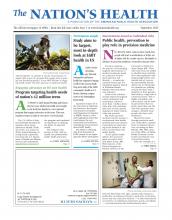The return of streetcars may be the bane of the Washington, D.C., transportation system or its potential savior.
Proponents and opponents of streetcars attempted to gain traction in a June 16 debate at the National Press Club. Marc Scribner, research fellow at the Competitive Enterprise Institute, argued against streetcar construction, while Dan Tangherlini, MBA, MPP, former administrator of the General Services Administration and former director of transportation for the District of Columbia, argued for it.
The importance of the streetcar lies not only in its transportation value but also in its connection with public health. The U.S. Department of Transportation reported 32,479 highway fatalities in 2011. However, the Department of Transportation reported only 25 light rail fatalities in 2011. Of course, there are far fewer light rail systems than U.S. highways.
Studies have provided evidence for the public health benefits of streetcars. For example, the Baltimore Red Line, a proposed 14-mile transit line, could provide more access to green space and reduce air pollution by lowering the number of cars on roads, according to a report. The Draft Environmental Impact Statement Air Quality Technical Report, released by Bottineau Transitway in August 2012, predicted that without the Red Line, 13,000 additional cars could be on the road by 2030. A study on the effects of the Portland, Oregon, streetcar system, released by the Office of Transportation and Portland Streetcar Inc., in April 2008, showed that ridership has grown from 3,500 weekday rides per day in 2001 to 11,900 weekday rides per day in 2008.
Streetcars have a long history of use in the United States and other regions of the world, with successful systems operating in cities such as San Francisco, New Orleans and Portland, Oregon.
Tangherlini said that although the streetcar may not be the most effective option in some cities, it could be beneficial for Washington, D.C. Streetcars can increase access to other forms of public transportation, such as D.C.’s subway system, and can provide more transportation options and present more opportunities for exercise, he said. According to a study in the July issue of APHA’s American Journal of Public Health, people who ride rail are more likely to walk than both car drivers and bus riders.
Streetcars were a mainstay of the D.C. transportation system until Jan. 28, 1962, when D.C. replaced streetcar services with buses. In response to a need to complement its bus and subway system, the District Department of Transportation released a study in September 2005 that identified four potential streetcar lines. Funding cuts and declining political support, however, reduced the number of initial lines to two streets of lanes in the city’s northeast quadrant. Future plans call for a total of four lanes, though the city’s mayor has not committed to the full plan this budget.
Despite the possible public safety benefits of streetcars in D.C., Scribner argued against them because, in his opinion, streetcars may not provide additional employment services and do not boost economic growth.
“Streetcars are an inefficient and obsolete mode of mass transit when compared to their modern alternatives,” Scribner said. “They serve to distract us from legitimate urban transportation issues.”
Some studies, however, have shown otherwise. The study from the Office of Transportation and Portland Streetcar Inc., showed that since 1997, $3.5 billion has been invested within two blocks of the alignment of the streetcar.
Alternatives to streetcars present other costs and challenges. According to a study by the Minneapolis city government on transit alternatives in Minneapolis published in 2013, an enhanced bus service could cost up to $93 million.
In the District’s proposed budget and financial plan for fiscal year 2016, Mayor Muriel Bowser proposed $345 million for the next six years of streetcar construction. Tangherlini said that officials should look at the context of cities to have a better understanding of how streetcars can benefit residents.
“This shouldn’t be a question of creating false questions of whether we do this or that,” Tangherlini said. “The question is how many investments do we need and how can we target those investments.”
For more information on the D.C. streetcar plan, visit www.dcstreetcar.com
- Copyright The Nation’s Health, American Public Health Association









